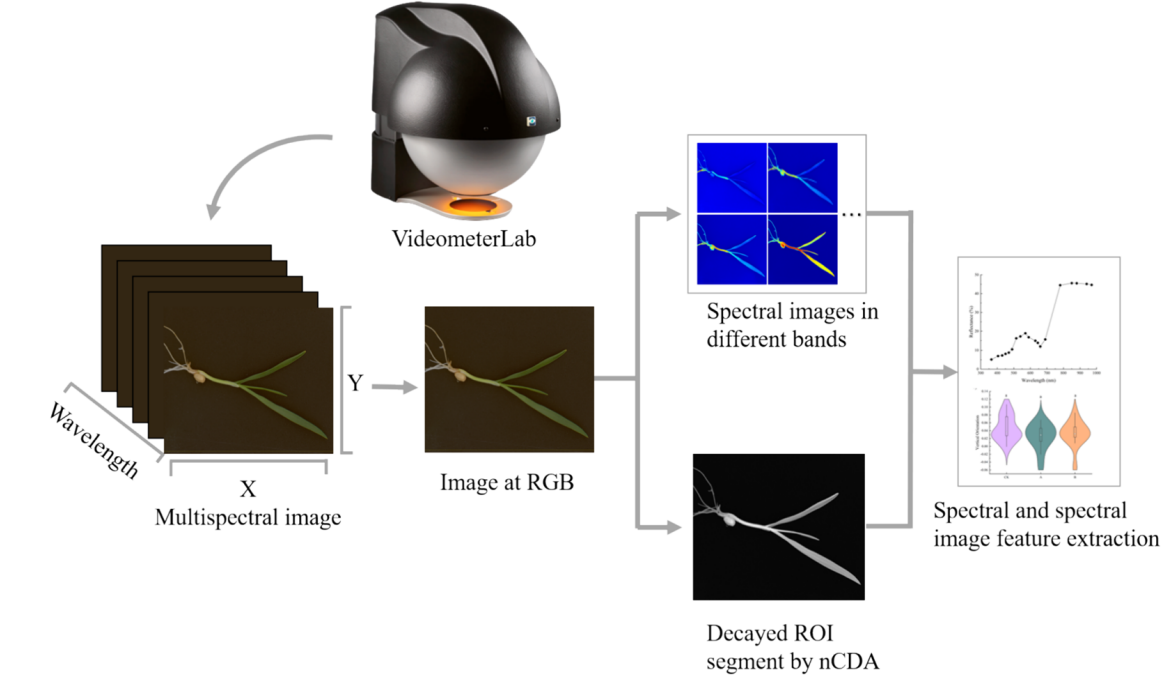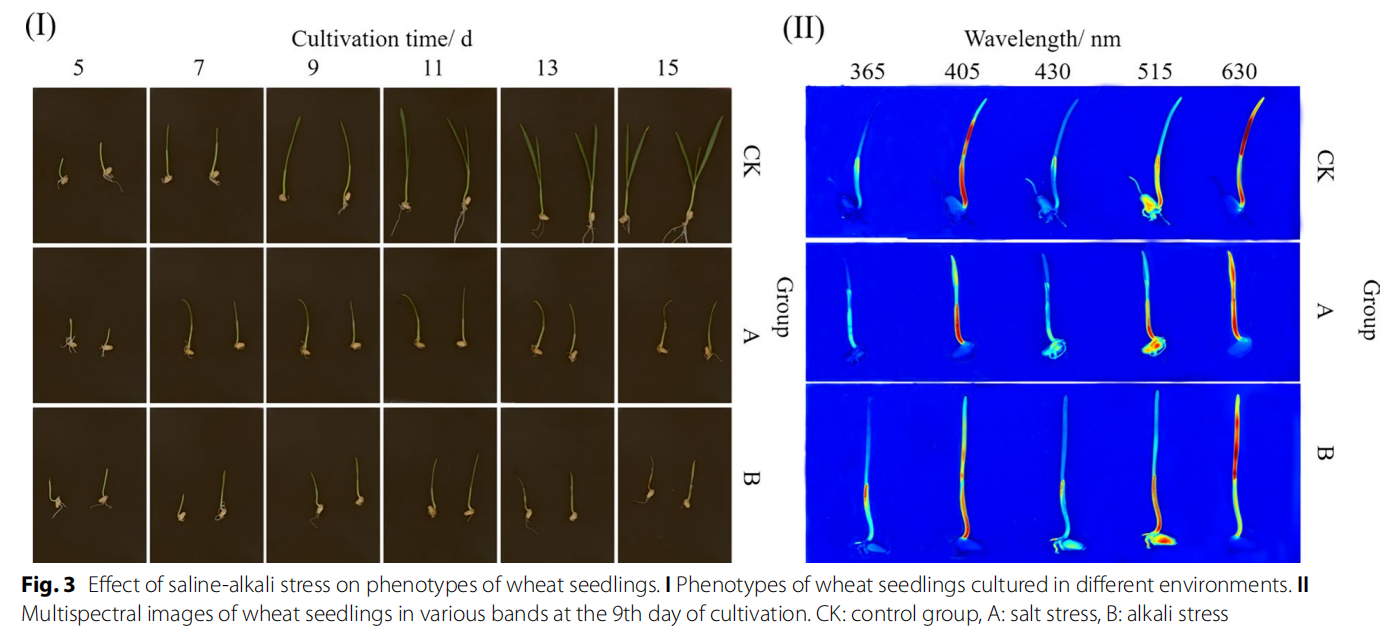品质至上,客户至上,您的满意就是我们的目标
技术文章
当前位置: 首页 > 技术文章
Videometer多光谱表型成像系统:通过融合技术无损检测小麦幼苗中的盐碱胁迫
发表时间:2024-09-09 13:03:38点击:160
来源:北京博普特科技有限公司
分享:
Videometer多光谱植物表型特征分析是一种新型的、功能强大且性价比较高的植物表型成像测量系统。基础模块包括可见光成像,UV紫外成像以及NIR成像。可固定摄像头或移动摄像头。因拍照速度迅速,可实现较高通量成像。但需要手工较换样品,可以测量较小的样品。但分析软件功能强大。可对拟南芥等小植株、用多孔板培养的植物、多孔板里的叶圆片、以及植物的种子等,可以间接的进行高通量测量(必须手工较换样品)。该系统也可以对细菌、小型动物、虫卵等进行高通量成像测量,进行毒理学或其它研究。通过控制系统就可以进行高分辨率多光谱成像。对于拟南芥等冠层平展的植物,可以进行自动的叶片计数等。
Videometer多光谱表型成像系统:通过融合技术无损检测小麦 (Triticum aestivum L.) 幼苗中的盐碱胁迫
摘要
背景
小麦 (Triticum aestivum L.) 是世界重要的粮食作物,其生长发育在不同阶段,尤其是在苗期,受到盐碱胁迫的严重影响。因此,盐碱胁迫下小麦幼苗的无损检测可为小麦育种、栽培和管理提供更全面的技术支持。
结果
本研究主要采用融合技术对小麦幼苗水分信号进行预测和盐碱胁迫分类。在收集和分析小麦幼苗的横向弛豫时间和多光谱成像 (MSI) 信息后,使用 4 种回归模型预测水分信号。将K最近邻 (KNN)算法和高斯朴素贝叶斯 (GNB) 模型与 fvefold 交叉验证相结合,对小麦幼苗胁迫的预测进行分类。结果表明,小麦幼苗通过一定的机制提高结合含水量,增强其盐碱胁迫。在相同 Na 浓度下,碱胁迫对小麦幼苗水分、生长和光谱的影响强于盐胁迫。梯度提升决策回归树模型在预测小麦水分信号方面表现最好,决定系数 (R2P) 为 0.98,均方根误差为 109.60。它还具有较短的训练时间 (1.48 s) 和高效的预测速度 (1300 obs/s)。与单独使用单个数据集相比,KNN 和 GNB 在对融合数据集进行分类时表现出显著增强的预测性能。特别是,GNB 模型在融合数据集上表现最佳,精度、召回率、准确率和 F1 分数分别为 90.30、88.89%、88.90% 和 0.90。
结论
在相同Na浓度下,碱胁迫对小麦含水量、光谱和生长的影响强于盐胁迫,更不利于小麦的生长。低场核磁共振与 MSI 技术的融合可以提高小麦胁迫的分类,为盐碱胁迫下小麦幼苗的快速准确监测提供了一种有效的技术方法。
关键词:低场核磁共振 多光谱成像 小麦幼苗 盐碱胁迫 无损检



Nondestructive detection of saline-alkali stress in wheat (Triticum aestivum L.) seedlings via fusion technology
Abstract
Background Wheat (Triticum aestivum L.) is an important grain crops in the world, and its growth and development in diferent stages is seriously afected by saline-alkali stress, especially in seedling stage. Therefore, nondestructive detection of wheat seedlings under saline-alkali stress can provide more comprehensive technical support for wheat breeding, cultivation and management.
Results This research focused on moisture signal prediction and classifcation of saline-alkali stress in wheat seedlings using fusion techniques. After collecting and analyzing transverse relaxation time and Multispectral imaging (MSI) information of wheat seedlings, four regression models were used to predict the moisture signal. K-Nearest Neighbor (KNN) and Gaussian-Naïve Bayes (GNB) models were combined with fvefold cross validation to classify the prediction of wheat seedling stress. The results showed that wheat seedlings would increase the bound water content through a certain mechanism to enhance their saline-alkali stress. Under the same Na concentration, the efect of alkali stress on moisture, growth and spectrum of wheat seedlings is stronger than salt stress. The Gradient Boosting Decision Regression Tree model performs the best in predicting wheat moisture signals, with a coeffcient of determination (R2P) of 0.98 and a root mean square error of 109.60. It also had a short training time (1.48 s) and an efcient prediction speed (1300 obs/s). The KNN and GNB demonstrated signifcantly enhanced predictive performance when classifying the fused dataset, compared to using single datasets individually. In particular, the GNB model performing best on the fused dataset, with Precision, Recall, Accuracy, and F1-score of 90.30, 88.89%, 88.90%, and 0.90, respectively.
Conclusions Under the same Na concentration, the efects of alkali stress on water content, spectrum, and growth of wheat were stronger than that of salt stress, which was more unfavorable to the growth of wheat. The fusion of low-feld nuclear magnetic resonance and MSI technology can improve the classifcation of wheat stress, and provide an efective technical method for rapid and accurate monitoring of wheat seedlings under saline-alkali stress.
Keywords Low-feld nuclear magnetic resonance, Multispectral imaging, Wheat seedlings, Saline-alkali stress, Nondestructive testing